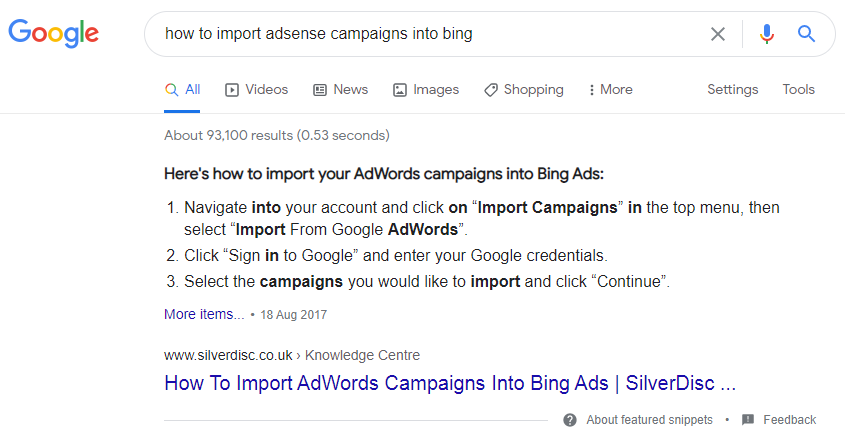
27th January 2021
How to Optimise Your Website for Featured Snippets
What are featured snippets, why are they important and how do you write and structure your website content to feature in them? Read on for a practical guide to optimising your website for featured snippets that you can start using right away.
This article explains how to structure your content for featured snippets by optimising new or existing content to target search queries. Other featured snippet strategies include adding how-to sections, FAQs and videos to your website to target informational queries and questions. However, before you tackle those, understanding the fundamentals and optimising your existing blog posts and other text is a great place to start.
What are featured snippets?
Featured snippets are search results that you may find at the top of Google’s organic search results and they are very desirable for businesses to appear in because they provide a much more prominent presence for the page in question. They take a few different forms and they aim to answer the user’s query straight away. They are also known as answer boxes and can be great for improving brand awareness.
It used to be that webpages listed in featured snippets appeared twice in the search results – once in the featured snippet, and again as a normal organic listing. Now, pages in featured snippets don’t feature in the normal organic list below, but featured snippets still offer a great opportunity for higher exposure.
Here is an example of a featured snippet:
Image

Why is it important to get into featured snippets?
To appear in featured snippets, you must create rich, useful content that addresses your visitors’ needs, while aiming for high page rankings - all of which is already part of a solid SEO strategy. So, by working towards featured snippets, your actions will have a knock-on effect for your SEO as a whole. And if you’ve already been working hard on your SEO, chances are you’ll have taken some steps towards optimising for featured snippets and you may already appear in them for one or two queries.
Types of featured snippets
There are three major types of featured snippets:
- Paragraph (an answer is given in text). This may also include the image that accompanies the text on your page, if there is one.
- List (an answer is given in a form of a bullet point or numbered list).
- Table (an answer is given in a table).
According to Getstat, the most common type of featured snippet is the paragraph, at 81.95%. Lists make up 10.77% of featured snippets, while tables cover the remaining 7.28%.
What do you need to do to qualify for a featured snippet?
To appear in a featured snippet, your page needs to already rank in the top ten organic search results for the query you are targeting. You don’t need to be in the first organic position.
The following types of search queries get featured results most often:
- DIY processes
- Health
- Financial
- Mathematical
- Requirements
- Status
- Transitional
However, if your content doesn’t lend itself to any of these, don’t be put off. Most featured snippets are triggered by long-tail keywords, particularly questions, so that’s one of the most important things to bear in mind, and you can target these types of query regardless of your industry or subject.
How to find keywords to target for featured snippets
Before you go about trying to get into featured snippets, it’s a good idea to check if you already appear in them for any of the keywords you are currently tracking. Then, the first thing you need to do to get into featured snippets is carry out keyword research so that you know which phrases you would like to target.
There are a few ways in which you can carry out keyword research for featured snippets:
- Start with question-type search queries (those containing question words, like “what,” “why,” “how,” etc.) because these are the easiest to identify. You can use Answer The Public, or Serpstat’s Questions section to find question search queries.
- Then, target informational intent phrases that aren’t questions.
- You can also find ideas by looking at Google’s “People also asked” section.
- Look in Search Console for keywords you already rank highly for, as these may be good featured snippet candidates. Look out in particular for question-based or informational queries and long-tail keywords. Order by position to find the best performing keywords and filter by words such as “how” to find informational queries.
- Use Twitter to search for queries – entering a keyword with a question mark will filter results containing questions, for example “digital marketing ?”
How to choose which keywords to target
It may sound counter-intuitive, but don’t worry too much about search volume for the queries you find. Research has found no direct correlation between search volume and whether a term triggers a featured snippet. Having said that, if you have a list of search terms you’d like to target, it makes sense to prioritise those with higher search volumes, as if you do get into a featured snippet, these may drive more traffic to your site.
You may also want to consider whether you should write an entire article or page around one search term, or target several related queries on one page by writing a paragraph about each. Again, search volume shouldn’t factor into this decision, but you should be guided by how much content you think you are able to provide about each search term, as well as how closely related they are and therefore how you could structure an article around them.
How to optimise content for featured snippets
Here are some ways to optimise new or existing content to appear in featured snippets:
1. Answer each question concisely
Google won’t show your entire page content in a featured snippet, as that would likely be far too long. Bear this in mind when writing your content – how can you answer the question or query within one paragraph that Google can pick out and show on the SERP?
This doesn’t mean your content should only be one paragraph, though – Google loves long-form content and you’ll likely need to expand your answer further and give more detail, so do that after you’ve written you initial paragraph addressing the question.
To target featured snippets, try to ask the target question, for example by putting it in a heading, and then answer it succinctly in a paragraph, list or table, before elaborating further.
2. Be factual and organize well
While we’re on the subject of paragraphs, lists and tables, remember that facts are very important when targeting featured snippets. Lists and tables in particular lend themselves well to displaying facts succinctly and in an easy to skim, organised way. When writing and optimising your content, remember that these different formats are available to you and consider whether they may be appropriate.
3. Answer similar questions in one article
If there are several questions you would like to target to get into featured snippets, and they are all very similar, it may be best to target all of these in one article. Otherwise, you will end up with lots of articles with the same content and purpose. Even if that helps you get into featured snippets, it could be confusing for your visitors, leading to a poor user experience, and it could also result in duplicate content or a poor website structure. If you have a few questions that are closely related, consider using a paragraph or section to target each one within the same article.
4. Organize your questions properly
If you’re going down the route of addressing several questions in one article, you’ll need to organise that article effectively. You could do this by thinking of your article – and the search queries you’re targeting – as having different levels. For example, as mentioned above, each question you address will need its own paragraph or section and sub-heading within your article. Your article itself should therefore use a slightly less specific search query that is appropriate for all of the questions you’re targeting. You may also be targeting multiple questions that are worded differently but ultimately mean the same thing, and these can go in one section together, rather than saying the same thing in different paragraphs or in different ways.
Think of your article like an upside down triangle – the focus gets narrower the deeper you get into the content. This can be true when writing articles anyway, in terms of the information you give to the reader – so it also applies when it comes to the search queries you target and add into your text.
How To Tracking Featured Snippets
Once you’ve identified the queries you’d like to get into featured snippets for, you can begin tracking them. At SilverDisc, we do this using Moz. When the keywords have been listed and Moz has populated the data, it’s possible to see if a website is appearing in featured snippets for any of the tracked keywords. If you’re not appearing in featured snippets yet, you’ll be able to make tweaks and continue to monitor your progress to get an idea of what may be working.
If you would like help with your featured snippets strategy or any other aspect of your SEO, get in touch with SilverDisc.






